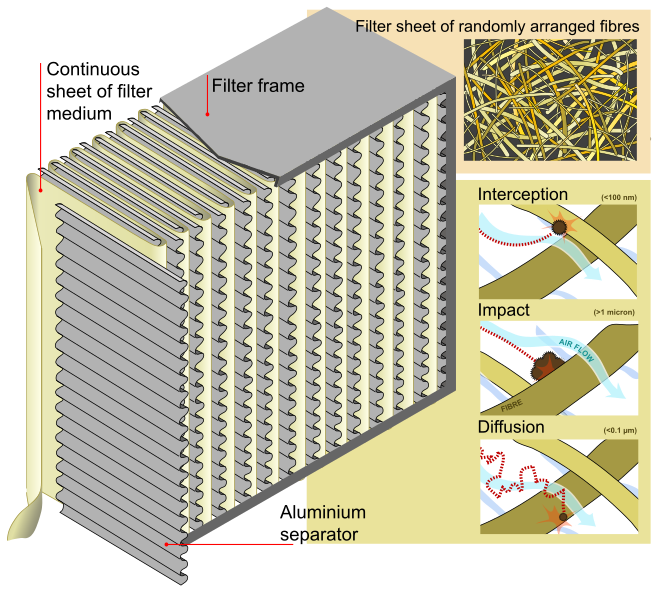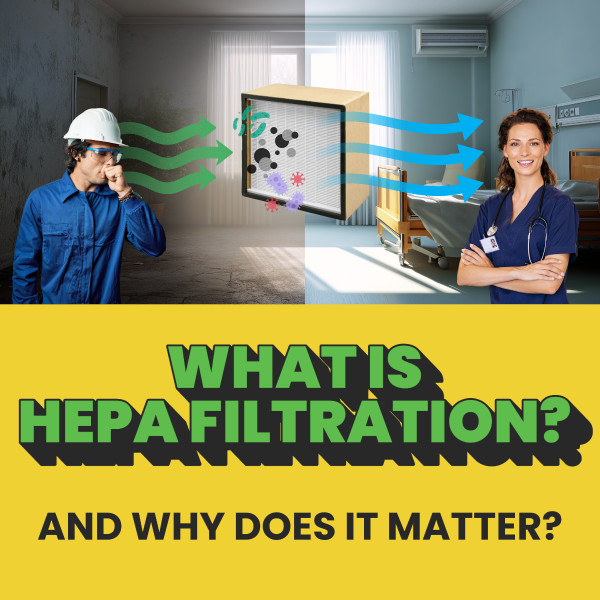What Is HEPA Filtration and Why Does It Matter?
In today’s world, air quality isn’t just a comfort—it’s a health and safety priority. HEPA filtration is the best option for controlling airborne particles. This is true whether you work in restoration, construction, or healthcare. Also important for those who value indoor air quality.
What Does HEPA Stand For?
HEPA means High Efficiency Particulate Air filter. Not a brand, but a performance standard for filters that remove 99.97% of airborne particles as small as 0.3 microns.
The field recognizes that 0.3 micron size is especially important—it’s known as the Most Penetrating Particle Size (MPPS). Researchers test HEPA filters against this size because it’s the hardest to trap. If a filter can stop this, it can stop almost anything else.
A Brief History of HEPA Air Filtration
Born from necessity during WWII, the HEPA standard was originally developed to trap radioactive particles. Once officials declassified the technology, it became essential in cleanrooms, hospitals, and labs. Now, people also use it in restoration, construction, and even in everyday homes.
Why HEPA Matters
Dust, mould, fibres, and smoke aren’t just annoying—they’re dangerous. Without proper air filtration, airborne contaminants can:
- Cause or worsen respiratory issues
- Increase exposure to silica dust and asbestos
- Spread mould spores and bacteria
- Pollute indoor air long after the work is done
A high-efficiency HEPA filter provides peace of mind that the air you breathe—or the air your clients breathe—is clean and safe.
What Does HEPA Capture?
HEPA filters are designed to trap smaller particles such as:
- Dust Mite Debris: 0.5–50 microns
- Household Dust: 0.05–100 microns
- Human Hair: 70–100 microns
- Bacteria: 0.35–10 microns
- Plant Spores & Mould: 6–200 microns
- Smoke Particles: 0.01–1 microns
A micron is one-millionth of a metre—so we’re discussing particles far too small for the naked eye to detect.
Understanding Different Dust Types
The danger of dust depends on its size, type, and exposure. Here’s a quick breakdown:
- Inhalable Dust (E-Dust): Up to 100 µm – e.g. pollen, cement dust
- Alveolar Dust (A-Dust): ≤5 µm – e.g. welding fumes (deep lung penetration)
- Ultra-Fine Dust (U-Dust): <0.1 µm – e.g. soot, combustion particles
- Fibre Dusts: Long, thin particles like asbestos or glass wool
Fine dust (A-Dust) is especially harmful because it overwhelms the lungs’ natural defences.

How Does a HEPA Filter Work?
HEPA filters use four methods of physically trapping particles:
- Impaction: Larger particles crash into the fibres
- Diffusion: Tiny particles bounce around and stick
- Interception: Particles follow the air stream and touch fibres
- Sieving: Large particles simply can’t pass through
Together, these methods allow HEPA filters to maintain incredible efficiency—even against the most evasive particles.
HEPA Filtration Levels: H13 vs H14
Not all HEPA filters are equal. Here’s how the grades differ:
|
Grade |
Efficiency |
Suitable For |
|---|---|---|
|
H13 |
99.95% at 0.3µm |
domestic, commercial, industrial |
|
H14 |
99.995% at 0.3µm |
hospital, medical |
HEPA-Grade Equipment Available from Restore Solutions
|
H13 Air Cleaners |
H14 Air Cleaners |
|---|---|
|
Heylo PF1000 |
HEPA Vacuums:
All true HEPA vacuums should use H-Class filters, and come with a test certificate verifying efficiency. Although, some HEPA vacuums will use M-Class HEPA filters.
What is the difference?
M-Class and H-Class vacuums capture different levels of hazardous dust, which designates them. M-class vacuums suit moderately hazardous dust, while H-class vacuums handle highly hazardous dust. The key difference lies in the level of filtration efficiency required for each class.
M-Class Vacuums
- Filtration Efficiency: M-class vacuums must capture at least 99.9% of dust particles smaller than 0.3 microns.
- Suitable for: Wood dust, metal dust, concrete dust, and plaster dust.
- Workplace Exposure Limit: Suitable for dust with a workplace exposure standard of greater than or equal to 0.1mg/m3.
H-Class Vacuums
- Filtration Efficiency: H-class vacuums must capture at least 99.995% of dust particles smaller than 0.3 microns.
- Suitable for: Highly hazardous dust like asbestos, lead dust, and silica dust.
- Workplace Exposure Limit: Suitable for dust with a workplace exposure standard of less than 0.1mg/m3.
Manufacturers design M-class vacuums for regular construction and industrial dust. Manufacturers build H-class vacuums to handle extremely dangerous dust that can harm health.
Not All "HEPA" Labels Are Legit
A true HEPA filter must come with:
- Certification (e.g. EN1822 or equivalent)
- Individual test result or serial number
- Manufacturer data proving 99.97%+ efficiency
Be wary of products that use the term “HEPA-like” or don’t offer documented test data.
The Bottom Line: Invest in Clean Air
HEPA filters are not just an add-on—they’re an essential component of safety, compliance, and professionalism.
- They protect technicians, clients, and properties.
- They reduce airborne hazards like mould, asbestos, and silica.
- They help you meet health, safety, and environmental regulations.
- They deliver confidence to clients and credibility to your brand.
When clean air matters, HEPA filtration is non-negotiable.
How Can I Be Confident In My Air Filter Setup?
Use a particle counter like the Trotec PC200 to measure the actual effectiveness of your air cleaner. By testing airborne particles before and after filtration, you can:
- Detect filter leaks or under performance
- Verify that your air filter is doing its job
- Capture data and photo proof for documentation and client reporting
Need help choosing the right HEPA air cleaner?
Get in touch with our team—we’re here to help you breathe easy, work safer, and restore with confidence.
Recent Posts
-
Start the Year Strong with Our Restocking Service
Because the busiest season is when you need the fewest surprises. The new year is already in full sw …3rd Jan 2026 -
Ten Years of Restore Solutions: Innovation for Restorers
In 2015, Restore Solutions entered the market with one clear purpose — to help restoration professio …2nd Dec 2025 -
The Ultimate Battery Operated Power Scrubber for Restoration Professionals
Less Elbow Grease, More Results: Meet the Battery-Powered Scrubber That Does the Hard Work for You S …17th Nov 2025




